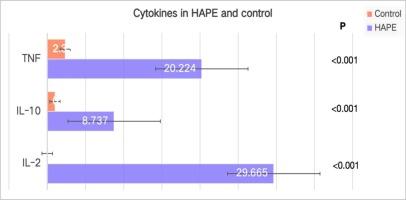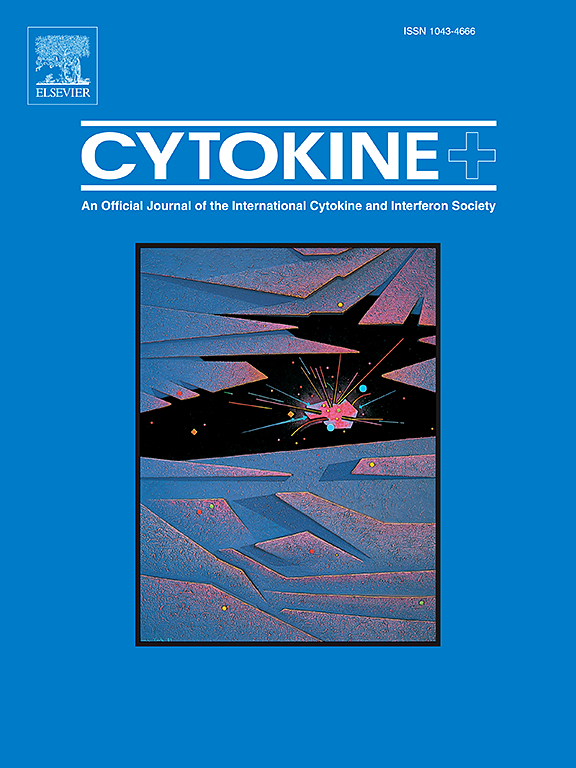高原肺水肿患者细胞因子水平升高。
IF 3.7
3区 医学
Q2 BIOCHEMISTRY & MOLECULAR BIOLOGY
引用次数: 0
摘要
背景:免疫调节是机体适应不同海拔的必要条件。然而,免疫调节对高原肺水肿(HAPE)发病的影响尚不清楚。本研究旨在通过评估细胞因子水平,探讨免疫调节对HAPE发病机制的影响。方法:我们分析了28例高海拔地区HAPE患者的细胞因子谱,并将其与25例成功适应环境的健康人进行了比较。采用细胞头阵列技术(CBA)定量分析了T辅助细胞(Th)1/2/17释放的7种细胞因子,以及血清中单核细胞趋化蛋白-1 (MCP-1)、白细胞介素(IL)-8和IL-1β的水平。结果:我们的研究结果显示,与健康个体相比,HAPE患者外周血中IL-2、IL-10和肿瘤坏死因子(TNF)的浓度显著升高(P结论:HAPE患者中IL-2、IL-10和TNF的升高强调了免疫失调是疾病的驱动因素。在临床上,这些细胞因子可能指导风险预测(il -2低氧血症相关)和靶向治疗(血管渗漏抗tnf)。未来的工作应该定义低氧特异性细胞因子网络,验证高原队列的干预措施,并整合多组学来绘制免疫-血管串扰。本文章由计算机程序翻译,如有差异,请以英文原文为准。

Elevated cytokine levels in patients with High-altitude pulmonary edema
Background
Immunomodulation is integral to the body's adaptation to varying altitudes. Nevertheless, the effects of immune regulation on the onset of high-altitude pulmonary edema (HAPE) are not well understood. This research aimed to explore the influence of immune regulation on HAPE pathogenesis through the assessment of cytokine levels.
Methods
We analyzed the cytokine profiles of 28 HAPE patients at high altitudes and compared them to 25 healthy individuals who had successfully acclimatized. The levels of seven cytokines released by T helper cells (Th)1/2/17, alongside monocyte chemoattractant protein-1 (MCP-1), interleukin (IL)-8, and IL-1β in serum, were quantified using cytometric bead array (CBA) technology.
Results
Our findings revealed significantly higher concentrations of IL-2, IL-10, and tumor necrosis factor (TNF) in the peripheral blood of HAPE patients when contrasted with those of healthy individuals (P < 0.001). A comprehensive analysis of these cytokines indicated a robust diagnostic capability for predicting HAPE, achieving an area under the curve (AUC) of 0.98. Conversely, no significant differences were observed in the levels of IL-6, IL-8, interferon-γ (IFN-γ), IL-4, IL-17 A, MCP-1, and IL-1β between the two cohorts.
Conclusions
Elevated IL-2, IL-10, and TNF in HAPE patients underscore immune dysregulation as a disease driver. Clinically, these cytokines may guide risk prediction (IL-2-hypoxemia link) and targeted therapies (anti-TNF for vascular leakage). Future work should define hypoxia-specific cytokine networks, validate interventions in altitude cohorts, and integrate multi-omics to map immune-vascular crosstalk.
求助全文
通过发布文献求助,成功后即可免费获取论文全文。
去求助
来源期刊

Cytokine
医学-免疫学
CiteScore
7.60
自引率
2.60%
发文量
262
审稿时长
48 days
期刊介绍:
The journal Cytokine has an open access mirror journal Cytokine: X, sharing the same aims and scope, editorial team, submission system and rigorous peer review.
* Devoted exclusively to the study of the molecular biology, genetics, biochemistry, immunology, genome-wide association studies, pathobiology, diagnostic and clinical applications of all known interleukins, hematopoietic factors, growth factors, cytotoxins, interferons, new cytokines, and chemokines, Cytokine provides comprehensive coverage of cytokines and their mechanisms of actions, 12 times a year by publishing original high quality refereed scientific papers from prominent investigators in both the academic and industrial sectors.
We will publish 3 major types of manuscripts:
1) Original manuscripts describing research results.
2) Basic and clinical reviews describing cytokine actions and regulation.
3) Short commentaries/perspectives on recently published aspects of cytokines, pathogenesis and clinical results.
 求助内容:
求助内容: 应助结果提醒方式:
应助结果提醒方式:


